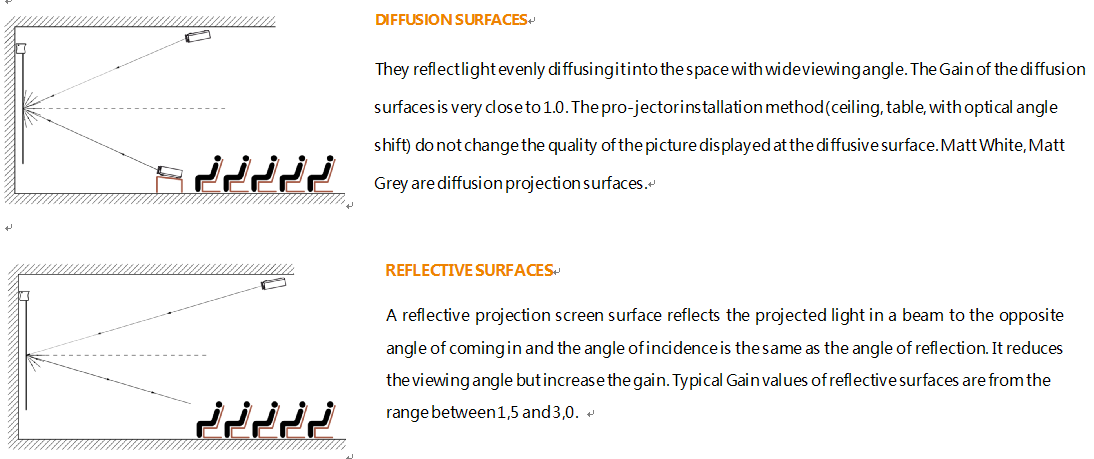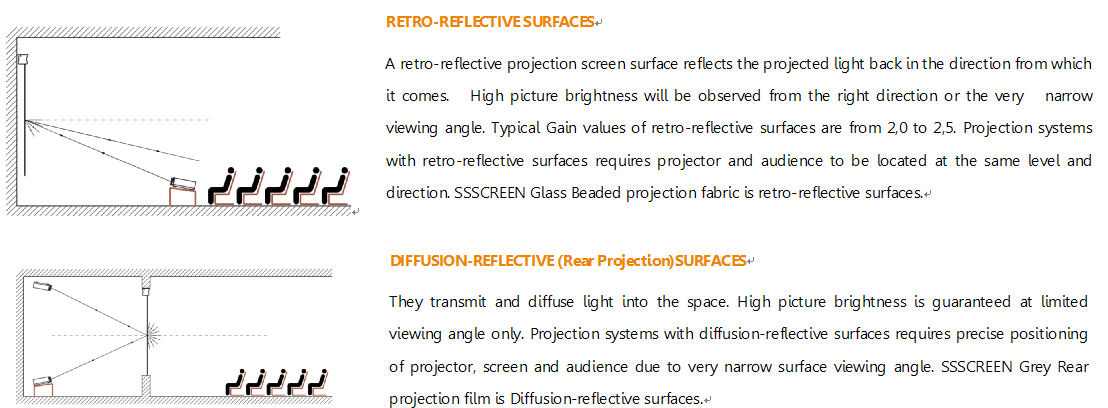Step 2: Choose Projection screen Surfac
Selecting the right projector screen fabric can seem very complicated, however the better you understand the purpose of a screen fabric, the easier it will be to decide what’s right for you. Different screen fabrics are designed to handle different applications depending on the resolution of the media being used, the lighting conditions, the viewing angle of the audience and the sound distribution within the environment.
The most important place to start when ing a screen fabric, are with the Gain and Viewing Angle of the fabric. There is a lot to know about each and how they affect each other (as gain increases viewing angle usually decreases). Having a basic understanding of these features prior to making your choice of a projector screen fabric, is the only way to ensure that you will make the most out of your equipment within the constraints of your environment.


- Which Projector Screen Material Is Right For Me?
The projection screen material right for you depends on your projector, physical space, projection method, lighting environment and other factors. Always choose the material that will be best for the majority of your viewing.
-What Is Ambient Light, Controlled Lighting, Low, Moderate Or High Lighting?
What About Dusk/Sunset? Do I Need A White Or Gray Screen?
Ambient light is any light that exists in your viewing environment. It may be indoor light fixtures or street lights, etc. If you have a dark room where the lights can be turned off we call this controlled light versus dealing with a street lamp, for example, which you may not have control over. An example of a dark viewing environment is a movie theater, low light might be a small light coming from the next room and high ambient light would be a light on in the same room as your screen.
Generally speaking, the darker you can get your viewing environment the better the results. We recommend using white projector screen materials for dark environments & gray projector screen materials for environments with ambient light. You will not need gray if you have a dark viewing environment. Gray only provides additional contrast if you have ambient lighting concerns.
Unfortunately, none of our materials are meant for full sunlight.
Ambient Light Rejecting Projector Screen Material is the absolute best solution for almost any indoor lighting including bright, high ambient light environments! Ambient Light Rejection is great even watching the big game during the middle of the day. This material is our most versatile lighting solution. ACMERA’s Ambient Light Rejecting Projector Screen Material is in develop and will coming soon.
Dusk/Sunset: If your only ambient light concern is 20 minutes of viewing time at dusk, go with white. If you will experience ambient light throughout the entire movie, even after the sun goes down, go with gray.
-Which Material Is Best For (HD) High-Definition?
All of our projector screen materials are compatible for HD projection, though your projector, of course, will need to be capable of projecting a native HD resolution. That said, because Matt White 4K PET Screen Film, White Black Projection Screen Film and Gray Black Projection Screen Film have essentially zero texture, they can provide the sharpest possible picture for your high-definition projected images.
-Which Material Is Best For 3D Movies?
It depends on the type of 3D system. There are two types of 3D; Active?3D (most common) and Passive?3D (2 projectors).
Matt White 4K PET Screen Film, White Black Projection Screen Film works great for everyday usage, HD and/or Active 3D in a dark viewing environment (Active?3D Glasses).
3D Projection Screen Film , 3D Perfect Flatness PET Screen Film , 3D Fiberglass Base Projection Screen Fabric are specialized product for Passive 3D movie viewing and is the best solution for the purpose of Passive 3D (Passive?3D Glasses). It is highly reflective and not necessarily meant for everyday usage - although we have had some people use it that way - it is not our recommendation.
Our other materials are not recommended for 3D usage.
-What is Ultra Short Focal Screen?
The Ultra Short Focal Frame Screen is produce by our Ultra Short Focal Projection Screen Film with Ultra narrow frame specifically designed for ultra-short-focal projectors to provide a large-screen performance in the close quarters of most residential or even training environments.
- Ambient Light Rejecting , Ultra Short Focal And 3D Silver Screen Are The Most Expensive - Are They The Best?
The best projection screen material right for you depends on your projector, physical space, projection method, lighting environment, frame and other factors.
Ambient Light Rejecting (ALR) is a specialized product for bright, high ambient lighting conditions. You may not need Ambient Light Rejection Material if you do not have bright lighting conditions or if you have other specialized requirements. ALR also works for both active 3D and with (2) passive 3D projectors when ambient light is controlled.
Ultra short focal is designed for ultra-short-focal projectors. And this also suitable for normal focal projectors, but not suitable for 3D.
3D Silver Screens are specialized product for passive 3D movie viewing and is the best solution for the purpose of passive 3D. It is highly reflective and not necessarily meant for everyday usage - although we have had some people use it that way - it is not our recommendation. Everyday, Non-passive 3D SilverScreen users may experience hotspots when paired with a bright projector.
-Does Rear Projection Film Work For Front-Projection?
In short, Gray Rear Projection Screen Film can but it is not its specialty. Our Gray Rear Projection Film is translucent and may work for front-projection; however, compared to an opaque front-projection screen, it will not be nearly as bright. Used in a rear-projection setup environment, though, it will rival any front-projection setup. If you do use Gray Rear Projection Screen Film for both front and rear projection; use a smaller seating viewing angle and make sure there is no light behind the screen as it will show through. Gray Rear Projection Screen Film works best in low ambient light situations.
-Can Front-Projection Screen Material Be Used For Rear-Projection?
No, sorry it cannot. Front-projection screen materials are opaque. The image will not show through the screen.
-Can I Get A Fabric Sample?
Yes! Check our CONTACT page and get touch with our sales right now!